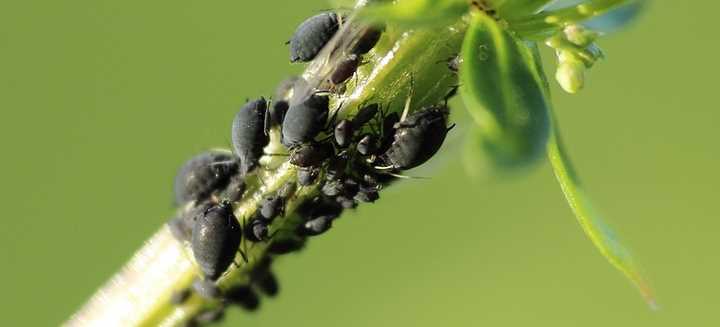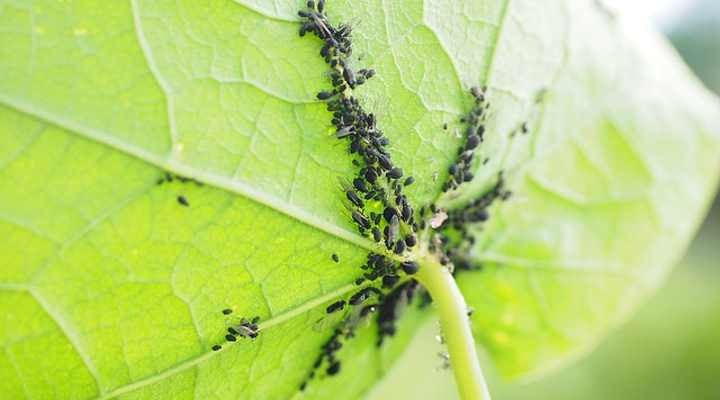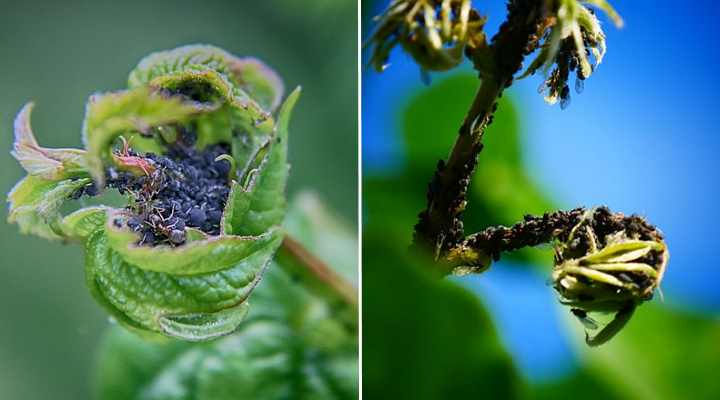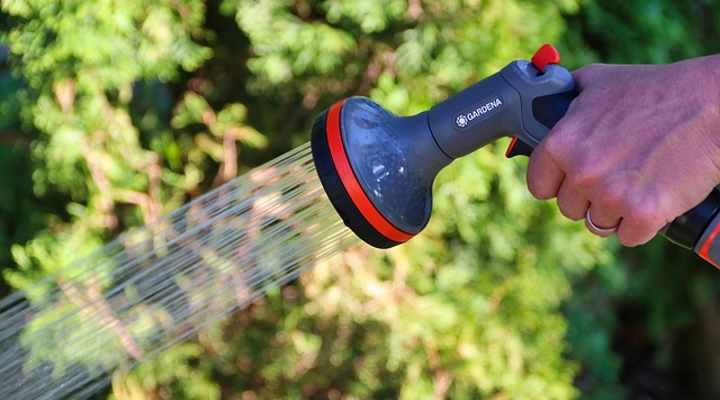Black aphids are tiny black pests that damage plant leaves and stems by sucking out their juices. Plant-destroying aphids, sometimes known as black bean aphids, tend to infest the underside of leaves. The sticky honeydew produced by black aphids, which attracts ants and causes sooty mold, may be seen easily. Thankfully, there are a variety of natural ways to exterminate and regulate black aphids.
The genus Aphis and the family Aphididae contain the black aphid (Aphis fabae), a insect species. One of over 5,000 species of aphids is the six-legged, soft-bodied insect. Plant-feeding aphids have piercing mouthparts that suck sap, just like all aphids do. Winged or not, black aphids exist. However, aphid infestations on garden plants and crops are harmful to all kinds of aphids.
Black bean aphid, blackfly, and beet leaf aphid are all common names for black aphids. The kinds of plants that black aphids prefer to feed on are referred to by these names. Beans, runner beans, and beets are among the top crops. Black aphids, however, can be found eating viburnum plants, chamomile, poppy flowers, and thistle. Unfortunately, a black aphid infestation can affect almost any plant in the garden.
This article provides an in-depth guide on identifying and eradicating black aphids. A multi-method pest control approach is needed to eliminate black aphids from plants. As a result, you’ll learn about the black aphid life cycle as well as ways to keep aphids out of your garden landscape.
What Do Black Aphids (Aphis fabae) Look Like?

The black aphid has a rounded, pear-shaped body with a bulbous abdomen, six light yellow legs, and two antennae. It is found in gardens and fields around the world. The light-colored legs and antennae of black aphids have black patterns on them, according to close-up images. At their back, there are two tube-like black cornicles.
Because they are only 0.12″ (3 mm) long, black aphids are difficult to detect. The fact that black aphids feed in large clusters makes it simpler to identify them than other aphid species with their dark-colored bodies. Some black aphids have wings, whereas others do not.
The slender body of the flying winged black aphid, in contrast to that of non-winged black aphids, lacks a tear-shaped body. Because they can easily infest nearby plants and crops, black aphids that fly (also known as blackflies) are a significant pest in gardens.
Adult aphids and black aphid nymphs resemble one another. Nonetheless, it is nearly impossible to detect them without a microscope due to their diameter of less than 1 mm.
Black Aphids Life Cycle

Depending on the season, a black aphid egg or live nymph may begin its life cycle. The black aphid takes around 15 days from hatching in the spring and molting several times before reaching adulthood. Live aphids are born without mating in the first generation of hatched females, which emerge in late winter/early spring. They may produce winged and wingless black aphids in various generations throughout their lifetime.
Female aphids of various colors mate in the autumn and lay eggs, which they carry over winter. The lifecycle of the aphid begins again the next spring. According to researchers, about 40% of black aphid eggs make it through the winter. There might be thousands of tiny soft-bodied insects on a single plant sucking the moisture from leaves and stems unless you take steps to manage black aphids throughout the winter, spring, and summer.
Getting rid of black aphids from your garden involves knowledge of their life cycle. During the winter, applying horticultural oils to plants is vital, particularly to those that have already hatched. After that, it is important to employ a variety of pest management strategies throughout the spring and summer to stop the black bean aphids from destroying your crops.
Where Do Black Aphids Come From?
Overwintering plants provide the black aphids. The eggs of black bean aphids are laid on around 300 different plant species. Throughout the winter, however, you’re more likely to find eggs on spindle tree leaves and viburnum bushes. Beet leaves, legume plant foliage, and most types of crops are home to the bothersome insects in the summer.
Aphids that fly from neighboring plants can also infest your plants. Moreover, they may transport your decorative plants, vegetables, and blooming shrubs from neighboring gardens, causing havoc.
How to Identify Black Aphids on Plants

Inspecting the underside of leaves is the quickest way to identify black aphids on plants. You’ll notice the telltale signs of hundreds of dark pear-shaped insects crawling around in clusters if your plants have aphid problems. The light-colored legs with black feet and pale yellow antennae distinguish these black, sap-sucking pests. Inspecting plant damage for black aphid identification is also possible.
Aphids cause misshapen or curled leaves, yellowing leaves, and poor plant growth as a result of their distinctive injury to plants. On plant stems, you may also see a sticky substance called honeydew that is amber in color and is a typical sign of an aphid invasion.

Honeydew, a sweet sticky residue on plants, aids in the detection of black aphids in two ways. The foliage first takes on a black sooty mold. Second, the aphid-infested plants attract more ants. Ants around the plant are one technique to identify black aphids (or any aphid species). Honeydew attracts ants. Beneficial insects like ladybugs will then be kept away from aphids, allowing them to be protected.

Have you seen tiny black bugs on hibiscus plants that are aphids that have left honeydew behind? Hundreds of little insects feeding on hibiscus leaves might be harming the plant’s development, and you may have black aphids on your hibiscus. On hibiscus plants, blasting them with a strong jet of water is often the best way to get rid of black aphids.
Signs of Black Aphid Plant Damage
Yellowing leaves that seem crinkled or withered, stunted development, sticky substances, and a sooty mold are all symptoms of black aphid damage to plants. Thousands of black aphids on a plant might deplete it to the point where it becomes vulnerable to bacterial infections, which may eventually kill the host. As a result, severe aphid infestation might be deadly to plants.
The following are some of the indications of plant infestation by black aphids:
Yellowing leaves: The leaves become yellow as a result of a nutrient shortage when black aphids suck the juice from leaf tissue. Look for blackfly, whitefly, or greenfly on the underside of yellowing leaves on your plants.
Foliage damage: The leaves of plants are withered, curled, or misshapen when black aphids feed on them.
A sticky substance on stems or leaves: Honeydew is left behind when black aphids suck sap. The sweet residue isn’t harmful to plants in and of itself. Other insects may be attracted to your prized garden shrubs, flowers, and crops, which may do more harm to them.
Black fungal growth: Black aphids feeding on plants and producing honeydew cause sooty mold to form. The plant’s appearance is harmed by the unsightly black substance.
Galls on plants: Another kind of harm caused by black aphids and other mites and bugs is bumpy growths on leaves, stems, branches, and roots.
How to Get Rid of Black Aphids on Plants
It may be difficult to get rid of black aphids. Using a pressurized hose to spray aphids’ stems and leaves is the most effective way to get rid of them. In addition, naturally occurring aphidicides include horticultural oils, insecticidal soaps, and neem oil. Ultimately, introducing predators may assist in the elimination of black aphid populations. Avoiding planting trees and shrubs that attract black aphids, maintaining garden plants and crops healthy, and not using broad-spectrum pesticides are some other effective ways to eliminate them.
Fast eradication of black aphids using chemical pesticides is possible. You will, however, kill helpful insects that feed on aphids. You reduce the chance of poisoning the food chain if you grow vegetables or fruits by using natural and eco-friendly pest control methods.
Wash Infested Plants to Eliminate Black Aphids

Hosing blackflies off plants is the quickest way to get rid of them. Soft-bodied black bean aphids can be eliminated with a super-strong stream of water, which kills the majority of them. Hibiscus, roses, bean plants, beet leaves, and other delicate garden leaves can all be exterminated using the water technique.
Prune Infested Garden Plants for Black Aphid Control
Remove infested stems and leaves to quickly eliminate black aphids from plants. Trim off the worst of the damaged foliage. By removing the annoying aphids while allowing the plant to concentrate energy on healthy parts of the plant, pruning aphid-damaged foliage and plant parts helps both.
Spray Plants with Neem Oil Spray to Kill Black Aphids

To exterminate the tiny black bugs on plants, apply an aphid spray with neem oil. Combine 2 tsp. of neem oil with water in a spray bottle. 1 tsp. of neem oil 1 quart (1 l) of water is used to make Castile soap. In a spray bottle, thoroughly mix the ingredients. Lastly, every week spray the leaves liberally to kill black aphids.
Neem oil is a natural insecticide for the Aphididae family (black bean aphid) according to scientific research. Neem oil solutions were found to be as effective as chemical insecticides in killing large numbers of black aphids in one research.
How to Use Insecticidal Soap to Get Rid of Black Aphids on Plants
Using insecticidal soap is a low-toxic way to get rid of black aphids from your garden plants. On contact, commercial insecticidal soap kills on/around soft-bodied insects such as black aphids. The outer coating of aphids is destroyed by the oils in the soap, killing them instantly. Follow the directions on the label of insecticidal soap to apply it to black aphid control.
Apply Rubbing Alcohol to Kill Black Aphids
In contact, rubbing alcohol (70%) is effective against black aphids. Soak a cloth in isopropyl alcohol and wipe down the infected plant foliage using it. To treat aphid infestations on leaves, you can use an alcohol spray. Mix 1 quart (1 l) of water with 1 cup of 70% rubbing alcohol to prepare a spray for black aphids. Spraying bottles are good for this. To eliminate the little black bugs, thoroughly drench all leaves, stems, and branches with the solution. For optimal results, use every seven days.
Winter is the best time to use a control method that prevents black aphids from hatching by wiping down foliage and stems. Moreover, the ethanol kills black aphid eggs effectively.
Introduce Beneficial Insects for Black Aphid Control

Predatory insects like ladybugs, lacewings, gall midges, and parasitic wasps help to drastically reduce black bean aphid populations by feeding on them. Mites and sap-sucking insects are eaten by the beneficial insects. As a result, you may get rid of aphids naturally and control them using the help of predatory insects.
How to Use Epsom Salt to Eradicate Black Aphids Naturally
Euthanasia of aphids by using Epsom salt might be achieved through direct contact. Many gardeners believe that an Epsom salt spray fungicidalpson natural aphid fungicidalpson that doesn’t harm plants.
Dissolve 2 tbsp. Epsom salt in a cup of hot water. Add 2 tsp. Epsom salt to a gallon (3.8 liter) of water. Castile soap is a kind of soap. To mix the ingredients, thoroughly stir them. A black aphid infestation has caused spray foliage, flowers, branches, and stems to exhibit signs. In the evening, spray foliage, then the next morning, wipe it down with a damp cloth.
Use Sticky Traps to Control Flying Black Aphids on Indoor Plants
The number of flying black aphids may be reduced by using yellow sticky traps. The flying black insects are drawn to the bright yellow color (some gardeners prefer blue sticky traps). The traps are then engaged and they perish. This, on the other hand, is only effective when combined with additional treatments to get rid of black aphids.
How to Use Diatomaceous Earth for Black Aphid Control
Diatomaceous earth (DE) is a nontoxic pest management strategy that may help you win the black aphid war. DE kills off all sorts of dangerous insects by eradicating their delicate bodies from the exterior. The little black bugs perish immediately after coming into contact with the white powder.
Sprinkle dry foliage with the powder to get rid of black aphids from plants using diatomaceous earth. To help minimize the quantity of black aphids on garden shrubs, fruit trees, vegetable leaves, and decorative plants, dust them once a week.
It’s important to keep in mind that diatomaceous earth is only effective as a contact pesticide when it’s dry. You must wait until the plants are completely dry before reapplying after it rains or you water them.
How to Prevent Black Aphids
Get rid of ants to control black aphids. Ants from aphid-infested plants must be eliminated. Aphids will be protected by ants, who will also attack predators. If you want to use beneficial insects to kill black aphids, the presence of ants may make natural Aphid Control ineffective.
Inspect new houseplants. Houseplants are seldom infested by black aphids. If you introduce aphids, however, they might be a big issue. Moreover, other plants may get infected quickly by the bothersome “bugs. In order to prevent any substantial pest infestation on your houseplants, inspect and isolate any new houseplants you acquire.
Introduce beneficial insects. Predatory insects like lacewings, parasitic wasps, and ladybugs may help to keep black aphids in check by regulating the environment.
Wipe plant foliage in winter. Wipe down plants with a diluted alcohol solution to prevent black aphids from hatching in the spring. Viburnum shrubs and the common spindle (Euonymus europaeus) are two of the plants that black aphids favor for egg production.
Avoid over-fertilizing plants. To prevent black aphids from attacking your plants, don’t over-fertilize them. Plants may be stressed and weakened by excessive fertilization, which attracts aphids that damage plants even more.
Use reflective mulch covers to prevent black aphids on garden plants. Reflective mulches like silver polythene, according to the University of California, may help control aphid populations on plants. Putting down reflective mulch on your plants early in the spring may help keep aphids at bay.
Avoid using broad-spectrum pesticides. To get rid of black aphids from your garden, it’s preferable to use natural pesticides instead of chemical ones since you’ll also eliminate helpful predatory insects.
